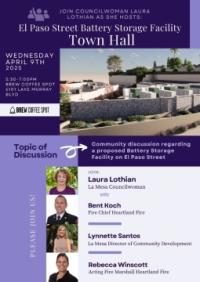TOWN HALL APRIL 9 ON PROPOSED BATTERY STORAGE FACILITY IN LA MESA

By Miriam Raftery
March 29, 2025 (La Mesa) – La Mesa Councilmember Laura Lothian will host a town hall community discussion on a battery storage facility proposed on El Paso St. The town hall will take place Wednesday, April 9 from 5:30 to 7 p.m. at Brew Coffee Spot, 6101 Lake Murray Blvd.
Heartland Fire Chief Brent Koch, Heartland Acting Fire Marshall Rebecca Winscott, and La Msa Director of Community Development Lynette Santos will also participate in the discussion.
Battery storage facilities are key to expanding renewable energy production such as wind and solar energy, enabling power to be utilized even when the sun doesn’t shine or the wind doesn’t blow.
But lithium ion battery storage facilites have also sparked fires, most notably a fire at a large battery storage site in Otay Mesa, where some nearby businesses had to evacuate for two weeks.
